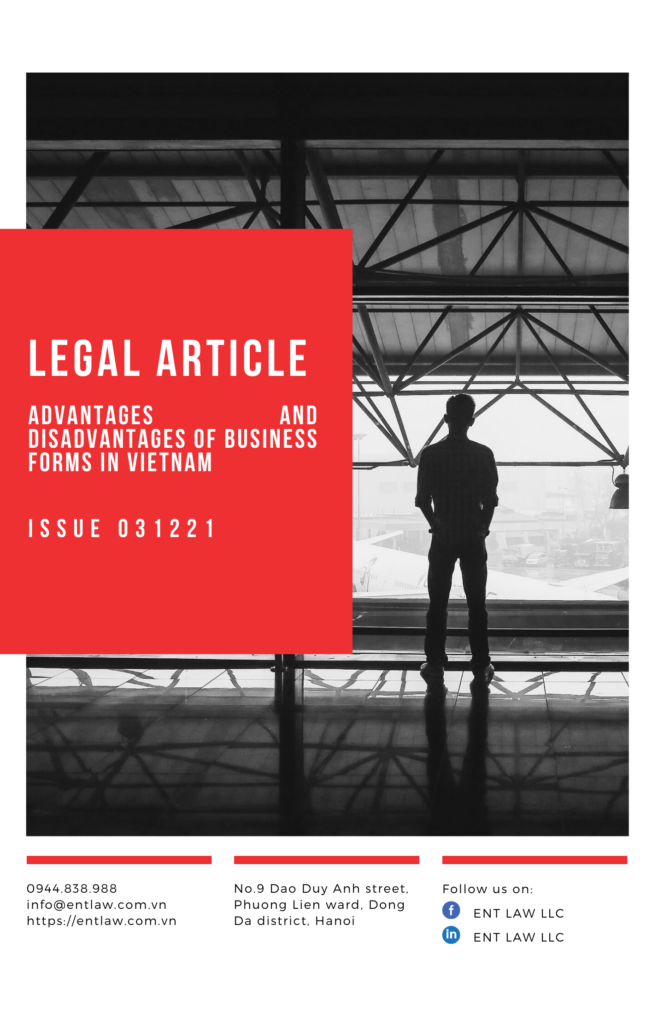Dear Valued Clients,
Pursuant to the Law on Enterprises, an enterprise could be organized in various forms with specific pros and cons. Accordingly, it is necessary and crucial for business owners to be aware of the features of each form in advance of business establishment. In order to provide the most preliminary awareness to Valued Clients, ENT Law shall summarize the most significant advantages and disadvantages of each form of enterprises in the following article.
In accordance with the 2020 Law on Enterprises, there are 5 forms of enterprises to be established in Vietnam, including:
1. Single-member limited liability companies.
2. Multi-member limited liability companies.
3. Joint stock companies.
4. Sole proprietorships.
Limited liability Company (“LLC”)
Features
General features of an LLC:
1. The one to establish an LLC can be either an individual or an organization.
2. The company has the status of a juridical person, the contributor(s) take(s) responsibility for the debts and other property liabilities within their contributed amount of capital in the company.
3. An LLC is not entitled to issue shares to raise capital.
An LLC is divided into two types, namely single-member LLC and multi-member LLC, which have the following specific advantages and disadvantages:
Single-member LLC
Advantages
1. There is only one owner, who has the right to make all decisions in the management and administration of the company.
2. Simple organizational structure, easy to manage.
3. The limited liability regime lessens the risk of the company owner during the company’s operation.
Disadvantages
1. The limited liability regime, in some cases, reduces the trust of partners that are willing to associate and cooperate with the company.
2. Restrictions in selecting capital increase methods. In case of increasing the charter capital by receiving capital contribution from a new member, the company must be converted to a multi-member LLC or a joint stock company[1].
Multi-member LLC
Advantages
1. The company members have the right to request the company to redeem their contributed capital in certain cases[2].
2. Regulations on the purchase and transfer of capital contributions among members of the company are quite strictly regulated by law. A member of the company must prioritize offering and transferring the capital to other members of the company over any other persons[3]. Accordingly, the company can easily control the capital contribution of members, limiting the entry of strangers into the company.
3. The company’s members only take limited liability for the debts and other property obligations of the company within the scope of their contributed capital.
Disadvantages
1. The limited liability regime, in some cases, reduces the trust of partners that are willing to associate and cooperate with the company.
2. The limitation of 50 capital contributors[4] restricts the ability to raise capital of this business form compared to a joint stock company.
3. Incapable to issue shares to the public.
4. Capital transfer tax rate is high (20%[5]).
Joint Stock Company (“JSC”)
Features
1. Having legal person status, the shareholders only take limited liability for the debts and other property obligations of the company within the scope of their contributed capital in the company.
2. The charter capital is divided into equal parts called shares.
3. Shareholders participating in capital contribution could be individuals or organizations; the number of shareholders ranges from 3 and there is no limit to the maximum number[6].
4. A JSC has the right to issue stocks and bonds to raise capital.
Advantages
1. A JSC can easily and flexibly raise capital because a JSC does not limit the number of shareholders and is entitled to issue shares to the public.
2. The procedure for transferring shares in a JSC is relatively simple, thus attracting investors to contribute capital to the company.
3. The limited liability regime lessens the risk of the shareholders during the company operation.
4. Low capital transfer tax rate (0.1%[7]).
Disadvantages
1. The limited liability regime, in some cases, reduces the trust from partners that are willing to associate and cooperate.
2. The management and operation of a JSC is very complicated due to the large number of shareholders, in which, many shareholders might not know each other, and there could be a division into groups of shareholders with antagonistic interests.
3. Within 3 years from the establishment date of the JSC, the ordinary shares of founding shareholder may not be transferred to any other person who is not a founding shareholder of the company without the consent of the General Meeting of the Shareholders[8].
4. Lawful rights and interests of shareholders or groups of minority shareholders are not guaranteed. In fact, in Vietnamese JSCs, the power of the company is concentrated mainly on the major shareholders and the executives and managers of the company, so for the JSCs with the Supervisory Board established as a formality or without an Internal Audit Committee, the interests of small shareholders may be affected.
5. The decision-making process is more complicated because it requires the approval of the Board of Directors and the General Meeting of Shareholders.
Sole Proprietorship (“SP”)
Features
1. No legal person status.
2. Owned by an individual who is solely responsible by all his/her assets for all business activities of the enterprise.
Advantages
1. Simple establishment procedure.
2. The owner of a SP is totally active and has full decision-making power in the management and operation of the business.SPs are less subject to strict legal constraints.
3. The business owner’s unlimited liability regime strengthens the trust for partners and customers.
Disadvantages
1. The unlimited liability regime poses great risks to private enterprise owners.
2. A SP is neither allowed to issue any type of securities, nor to sell their contributed capital to other individuals or organizations, so they cannot raise capital from outside.
3. The owner of a SP is only entitled to establish 01 SP and is not allowed to contribute capital to the establishment or purchase shares or contributed capital in any other business forms[9].
Partnership
Features[10]
1. Having legal person status.
2. Members: There are at least 2 general partners who are joint owners of the company and limited partners who are capital contributors (if any).
3. General partners: are individuals having unlimited liability with all their assets for the obligations of the company.
4. Limited partners: are organizations or individuals who are only responsible for the company’s debts and other property obligations to the extent of their contributed capital.
Advantages
1. The management and operation of a partnership is not too complicated due to limited numbers of members.
2. The unlimited liability regime of general partners creates the trust of partners.
Disadvantages
1. The risk of the general partners is high due to the unlimited liability regime.
2. A general partner may not be either the owner of a SP, or a general partner of another partnership and is not capable to transfer his/her contributed capital to another individual or organization without the consent of the other general partner[11].
3. The limited partners do not have the right to manage the company.
4. The company is not allowed to issue shares to raise capital.
As usual, we hope you find this Legal Article useful and look forward to working with you in the future.
Kind regards,
ENT Law LLC
The full version of this Legal Article can be found here.
———————————————————————-
[1] Under Article 87.2 of the 2020 Law on Enterprises.
[2] Under Article 51.1 of the 2020 Law on Enterprises.
[3] Under Article 52.1 of the 2020 Law on Enterprises.
[4] Under Article 46.1 of the 2020 Law on Enterprises.
[5] Under Article 11.1.b of the Circular No. 111/2013/TT-BTC guiding the Law on Personal Income Tax.
[6] Under Article 111.1(b) of the 2020 Law on Enterprises.
[7] Under Article 11.2.b(2) of the Circular No. 111/2013/TT-BTC guiding the Law on Personal Income Tax.
[8] Under Article 120.3 of the 2020 Law on Enterprises.
[9] Under Article 188 of the 2020 Law on Enterprises.
[10] Under Article 177.1 of the 2020 Law on Enterprises.
[11] Under Article 180 of the 2020 Law on Enterprises.

 Tiếng Việt
Tiếng Việt



RECRUITMENT ANNOUNCEMENT
Position Lawyer / Trainee Lawyer(Priority given to candidates who are currently enrolled in or have completed the Lawyer...
Jan
Issue of December 2025 – Amended Personal Income Tax Law
Dear Valued Clients, The National Assembly of Vietnam officially adopted the Fourth Draft of the Law on Personal...
Dec
ENT Law LLC at TECHFEST Vietnam 2025 – Hanoi
Dear Clients, Associates and Friends, ENT Law LLC is honored to take part in TECHFEST Vietnam 2025, the...
Dec
Issue 021225 – Important points to note in the execution of the labor contract
Dear Valued Clients, The labor contract is the main legal basis regulating the rights and obligations between the...
Dec